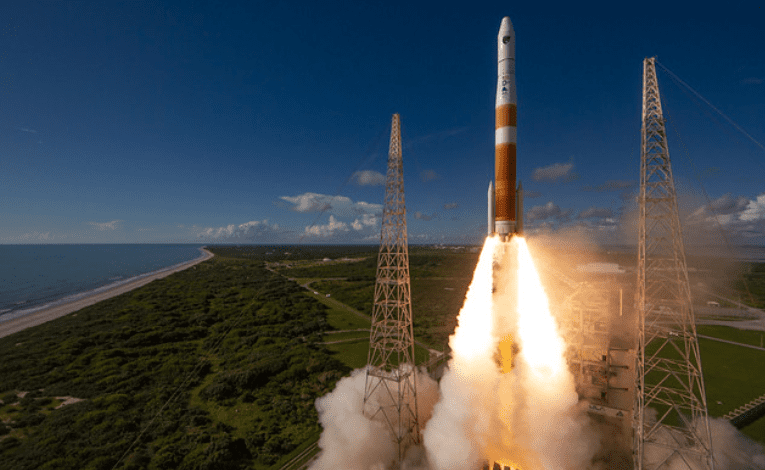Latest News

A ULA Delta IV rocket carrying the GPS III SV-2 mission for the U.S. Air Force Space and Missile Systems Center lifts off from Space Launch Complex-37 on Aug. 22, 2019. (Photo: ULA)
The first U.S. Space Force budget request allocates two-thirds of its proposed funding to research-and-development efforts in recognition of Pentagon priorities to build resilient architectures and new capabilities to challenge potential adversaries in the space domain.
The Defense Department’s (DoD) fiscal year 2021 presidential budget request includes $15.4 billion for the Space Force, according to budget documents released Feb. 10. The vast majority of those funds would be transferred over from the Air Force in the form of existing procurement and R&D programs. The Space Force was established Dec. 20, 2020 under the fiscal year 2020 National Defense Authorization Act.
Of that $15 billion, $10.3 billion would be allocated to research, development, test and evaluation (RDT&E) should Congress approve the budget request. The Space Force’s procurement budget would receive an additional $2.4 billion, while $2.5 billion would go to service operations and maintenance funds and $800 million would be allocated to military personnel funds.
Budget documents detail $1.6 billion for National Security Space Launch (NSSL) activities in FY ’21, including three competitively procured launches for a little over $1 billion and $561 million in RDT&E funds, up from $432 million in FY ’20.
The launches would be awarded via the ongoing Launch Services Procurement (LSP) program, for which Blue Origin, Space X, Northrop Grumman Innovations Systems and United Launch Alliance (ULA) are currently competing to be named one of two future launch service providers for national security missions. ULA is a launch alliance between Boeing and Lockheed Martin.
The budget request also includes funding for integration and launch costs for the fifth and sixth Space-Based Infrared Systems (SBIRS) Geosynchronous space vehicles, which are currently scheduled to launch in 2021 and 2022 as replenishment vehicles. It continues funding for protected satellite communications programs including the Evolved Strategic SATCOM (ESS) and Enhanced Polar System-Recapitalization (EPS-R) developmental satellites.
The FY ’21 budget requests sees increases to the Space Force’s highest R&D priorities. The Lockheed Martin-led next-generation overhead persistent infrared (OPIR) program to develop new early missile warning satellites has $2.3 billion requested, up from about $1.4 billion in the FY ’20 enacted budget.
That includes funding for ground systems including the Future Operationally Resilient Ground Evolution (FORGE) program, for which Raytheon won a $197 million five-year contract in January. Pentagon documents confirmed Next-Gen OPIR Block 0 is scheduled to launch five satellites, including three to Geosynchronous Orbit (GEO) in 2025, 2027 and 2028, and two Polar free-flyer satellites in Highly Elliptical Orbit (HEO) with target launch dates in 2027 and 2029.
The Space Force request continues ongoing upgrades to the GPS constellation and its associated ground control systems, including $482 million for the Raytheon-led Operations Control System (OCX) and $391 million for military GPS user equipment. The Lockheed Martin-led GPS III and GPS III Follow-On programs could receive about $664 million in procurement funds to buy the 14th and 15th GPS III space vehicles.
Budget documents noted that the Space Force RDT&E request funds a new budget activity, dubbed Software and Digital Technology pilot programs, which would provide for a space command and control (C2) missile system software program “to demonstrate our ability to leverage commercial best practices to deliver capability for evolving warfighter priorities.”
The documents also reveal that space-related classified funding is expected to transfer from the Air Force Rapid Capabilities Office, the Space Rapid Capabilities Office and other Air Force agencies to the Space Force. “Of note, funding related to the National Reconnaissance Office will not transfer into the U.S. Space Force,” the budget documents said.
Overall, the Defense Department plans to invest $18 billion overall in space capabilities. On top of the $15 billion to be committed to the Space Force and its programs, investments will be made to continue the standup of U.S. Space Command, the U.S. military’s newest unified combatant command established in August 2019, and the nascent Space Development Agency (SDA).
Get the latest Via Satellite news!
Subscribe Now